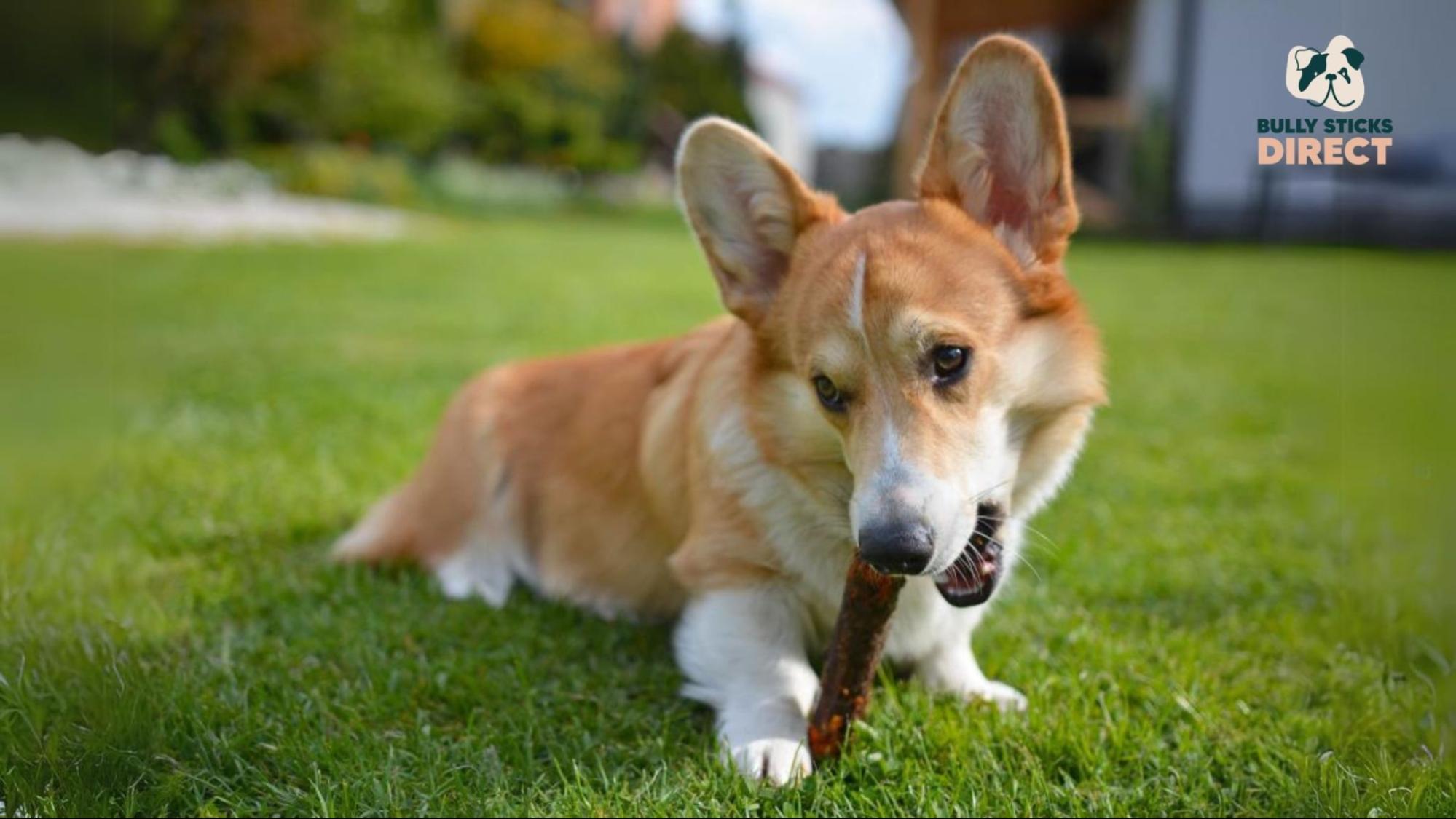Gnaw Problem Here: Bully Sticks for Teething Pups
Posted by Greg C. on Nov 11, 2024
For new dog owners, managing puppy teething can be challenging. Like human babies, puppies experience gum discomfort as their teeth grow in, which can lead them to chew on anything within reach, such as furniture or shoes. Preventing these harmful chewing habits requires safe and appropriate chew options.
For puppies in the teething phase, bully sticks are a great aid in easing discomfort, keeping them mentally stimulated, and teaching them proper chewing behaviors. This guide walks you through the advantages of bully sticks for teething puppies, key safety precautions, and tips on finding the right chew for your little one.
1. What Is Puppy Teething?
About 3 to 4 weeks is when puppies begin teething, with the emergence of their baby, or deciduous, teeth. Teething continues until puppies are roughly 5 to 7 months old. Between the ages of 3 and 4 months, their baby teeth start being replaced by adult teeth, a process that generally completes around 6 months. Teething often brings symptoms like loss of appetite, mild pain, and increased biting. Puppies chew to reduce their discomfort, though they may need guidance to avoid unsuitable items as they naturally explore their environment.
2. Signs of Teething in Puppies
Puppy teething is often a challenging phase, but knowing what to watch for can help you offer the right care. Here are some typical signs of teething in puppies:
- Drooling: If you see your puppy drooling more than usual, it’s likely because their mouth is producing extra saliva to help alleviate the discomfort of teething.
- Chewing: Puppies who are teething will gnaw on anything they can find, from toys to furniture, to relieve the pressure and pain in their gums. Providing appropriate chew toys can help save your belongings.
- Whining: The discomfort and pain from teething can make puppies whine or whimper more than usual. This is a normal part of the teething process.
- Swelling: You might see some swelling in your puppy’s gums, especially around the areas where new teeth are erupting. This is a clear indication that their adult teeth are coming in.
- Loss of Appetite: Some puppies may lose their appetite because of the discomfort and pain caused by teething. If your puppy loses their appetite, it could be a sign they’re teething.
- Irritability: Teething can make puppies irritable and restless. They might have trouble settling down, especially if they’re not getting enough relief from the pain.
Noticing these signs can help you provide the right care and comfort for your teething puppy, making the process a bit easier for both of you.
2. Why Bully Sticks Are a Great Option for Teething Puppies
Crafted from natural beef, bully sticks are made with one ingredient and are dog chews, specifically from the muscle or pizzle of the bull. These chews are low in fat, long-lasting, and high-protein, making them an excellent choice for puppies, especially those in the teething phase. Since puppies generally chew to relieve discomfort, providing the right teething toys is critical to preventing destructive behaviors. Here’s why bully sticks are a perfect option for teething puppies and how they support healthy chewing habits.
- Reduces Teething Pain: By massaging sensitive gums, bully sticks give puppies relief, helping them manage the discomfort of teething more easily.
- Natural and Easily Digested: Because they consist of only one ingredient, bully sticks are gentle on a puppy's digestive system, unlike synthetic chews.
- Promotes Positive Chewing Habits: Giving puppies bully sticks encourages them to chew on appropriate items, reducing the chance of unwanted chewing behavior.
- Packed with Nutrition: Rich in proteins and amino acids, bully sticks contribute to a puppy’s healthy growth and support developing muscles and bones.
3. Safety Considerations for Giving Bully Sticks to Puppies
While bully sticks can be beneficial, there are a few safety tips to keep in mind when giving them to teething puppies:
- Size Matters: Pick a bully stick that’s large enough so it won’t be swallowed but small enough for your puppy to grip.
- Keep chew toys available as they grow. Even as puppies become adults, it’s important to provide safe, appropriate chews to maintain their dental health.
- Oversee Each Chewing Session: While your puppy is chewing to prevent choking incidents or accidental swallowing, ensure to monitor their session.
- Limit Chewing Time Initially: Begin with 10-15 minute chewing times, increasing slowly as you see how well your puppy tolerates it.
- Check the Bully Stick Often: Routinely inspect for worn-out or small pieces that could be hazardous, and discard the chew once it’s too small to hold securely.
5. Common Mistakes to Avoid When Using Bully Sticks for Teething Puppies
Bully sticks can be an excellent option for teething puppies, but it’s critical to use them correctly to avoid any potential risks. Here are some common mistakes to avoid when using bully sticks for teething puppies:
- Incorrect Sizing: Selecting the proper size of the bully stick is important for your puppy’s safety. Thicker sticks can present a choking hazard for smaller pups, while thin ones may not provide adequate relief. Choose a size that’s easy for your puppy to chew on without the risk of swallowing.
- Lack of supervision: Always keep a close eye on your puppy when they’re chewing a bully stick. This helps prevent choking or the ingestion of small, broken pieces that could be dangerous.
- Failing to Rotate Chews and Toys: Regularly swapping out your puppy’s toys, including bully sticks, helps keep them interested and prevents attachment to a single item. This rotation can reduce boredom and keep playtime fresh.
- Not Watching for Choking Signs: Observe your puppy for any signs of choking, like coughing or trouble breathing. Should you notice these signs, take quick action to safeguard your pup.
- Selecting Unsafe Materials: Choose bully sticks made with natural, safe materials to protect your pup’s health, as they’ll probably chew on and ingest parts of the stick.
By avoiding these common mistakes, you can confirm that your puppy gets the most out of their bully sticks and stays safe during the teething process.
4. How Bully Sticks Help with Healthy Jaw Development
As puppies start teething, they’re doing more than just growing their adult teeth—they’re also working on building stronger jaws. Bully sticks give them just the right amount of resistance to help those muscles develop while giving them a safe, satisfying way to chew. Plus, this activity helps them burn off some extra energy, leaving them calmer and much easier to handle. Puppies get both physical and mental benefits by chewing naturally, which helps them grow, making bully sticks a great companion for the teething phase.
5. Choosing the Best Type of Bully Stick for Your Puppy
Bully sticks come in various shapes, sizes, and flavors, so it’s essential to select one that fits your puppy’s size and chewing style. Here are some tips:
- Select Thinner Bully Sticks for Little Puppies For smaller puppies, thinner bully sticks can be easier for them to hold onto and chew, making the experience more enjoyable.
- Go for Odor-Free Bully Sticks: Puppies can be sensitive at times to strong smells. Odor-free options are a great choice if you want something gentle on your puppy’s nose—and keeps your home smelling fresh!
- Mix Things Up with Braided or Spiral Sticks: These unique shapes give your puppy a little extra challenge, keeping them entertained and helping clean their teeth, too.
- Hold Off on Jumbo or Hard Sticks: Since puppies have delicate teeth, start with softer or smaller bully sticks until they’re a bit older and their teeth are fully developed.
6. How to Introduce Bully Sticks to a Teething Puppy
Introducing bully sticks to a teething puppy is straightforward, but a few steps can help make the experience safer and more enjoyable:
- Let Them Get Used to It: Begin by allowing your puppy to sniff the bully stick to get familiar with it. Hold it gently while they check it out; this helps them feel safe and comfortable before they start chewing on their own.
- See How They React: Pay close attention to how your puppy interacts with the bully stick for the first time. Some may be very eager and dive right in, while others might take a bit to explore.
- Save for After Meals: Offer the bully stick as a treat after meals. This stops your beloved puppy from overeating and encourages them to chew just for enjoyment rather than hunger.
7. Benefits Beyond Teething: Long-Term Value of Bully Sticks
While bully sticks are excellent for teething puppies, their benefits extend beyond this phase. As your puppy grows, bully sticks can continue to play a valuable role in their diet and mental stimulation. Here are some long-term benefits:
- Supports Dental Health: Chewing bully sticks helps keep your puppy’s teeth clean by gently scraping away tartar and plaque. Puppies naturally chew to ease teething discomfort, and providing safe chew toys can support their oral health as they grow.
- Reduces Anxiety: Chewing is a relaxing activity for dogs of all ages, helping to relieve anxiety and reduce stress.
- Encourages Positive Chewing Habits: Offering bully sticks consistently reinforces healthy chewing habits, guiding puppies away from destructive behavior and encouraging appropriate choices as they develop.
8. Alternatives to bully sticks for teething puppies
While bully sticks are an excellent choice, some puppies may need variety. Here are a few alternatives for safe, engaging teething chews:
- Frozen Carrots: Gentle on young gums, these frosty treats offer a safe chew that comforts puppies as they go through the stages of teething.
- Ice Cubes: Whether plain or broth-based, ice cubes give puppies a satisfying chill, helping to soothe their gums and ease the teething process.
- Rubber Chew Toys: Choose soft yet durable rubber toys that puppies can chew safely to ease their pain.
Using a variety of textures and shapes keeps your puppy engaged, relieves discomfort, and encourages healthy chewing practices, which are helpful as they grow.
Bully sticks are the ideal choice for teething puppies—they’re safe, healthy, and enjoyable. Not only can they help soothe sore gums, but they also support dental health, build jaw strength, and keep puppies mentally engaged. By choosing the right size, supervising their chew time, and keeping an eye on how they react, you can feel confident giving your pup this treat. Your puppy will get comfort and satisfaction from safe chewing, and you’ll have peace of mind knowing they’re enjoying a natural, digestible option.
If you need guidance on our full range of products then Check out our Guide To Choosing the Right Bully Stick For Your Dog. Happy Chewsing!



